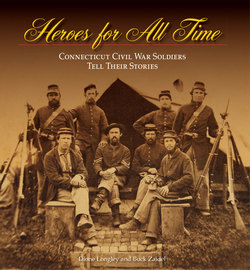Читать книгу Heroes for All Time - Dione Longley - Страница 7
На сайте Литреса книга снята с продажи.
ОглавлениеPREFACE
This is a book of stories.
Every Civil War soldier had a story. The stories were as varied as the men and boys who enlisted. And over 50,000 of them came from Connecticut.
In this book you will hear the voices of those Connecticut soldiers—not the interpretations of modern Civil War scholars, but the words of the men who actually fought the war.
Many were eager to share their war experiences in letters home, often finding relief in pouring out their feelings. “That night after the battle I never shall forget the groans and sreiks of the wounded,” a shaken soldier reported to his mother.1 Others kept diaries, recording dramatic events and snippets of daily life. “Thanksgiving. Snow Storm. Shoes full of holes, think of home,” wrote a woebegone teenager from Gales Ferry.2 And in the years after the war, some veterans felt the need to preserve their stories in memoirs. A Suffield cigar maker hoped his reminiscences would “awaken in my Children a deep love of the Government that their Father shouldered his musket to defend.”3
Some soldiers wrote eloquently, like Henry Camp, a Yale graduate and infantry officer: “We were to storm the fort. Our hearts beat high and fast … The feeling was not of doubt or shrinking, but of curiosity mingled with firm resolve.”4 Just as moving were the words of men like Lucien Dunham of Warehouse Point, who mused about the Confederates and the war: “it dident sean like they wear enmeys to us if they would let the soilders come together they would settle this prutey quick.”5
While some soldiers used the written word, many men chose to document their history in a different medium: photography. The camera caught their proud expressions as they posed in their new uniforms; or their weathered, philosophical faces transformed by hard service and the appalling scenes they had witnessed. In some images, a man’s intensity of gaze conveyed his resolve more clearly than any letter could.
Soldiers often brought home artifacts that held important memories. Levi Jewett carefully preserved his felt hat, marked with a bloodstained gash from a shell fragment that wounded him. George Stannard’s family treasured the bone ring he carved on the battlefield at Antietam. Such personal mementoes are vehicles to the past, connecting us to a soldier’s story with surprising immediacy.
Together, the individual stories of Connecticut soldiers create an astonishing whole that lays out the war before us. We offer this book so that, as one old soldier put it, “our children’s children may see with their eyes, as we saw with our eyes, the scenes and places of the great War for the Union. Lest we and they forget.”6
